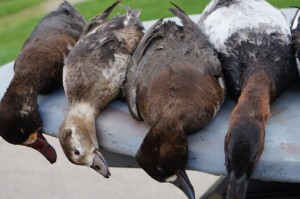Colder temperatures prevailed across the northern tier of our nation this past week – igniting of a burst of migration activity for blue-winged teal and wood ducks. The unseasonably warm days of early October have transformed into blustery, cold winds, flurries and even snow accumulation in the Great Lakes region. While one would expect a full-on barrage of fresh migrants in the north, the temperatures have done little more than push early migrants south as the hardy ducks continue to trickle down the flyways.
Hello folks, and, as always, welcome to Waterfowler.com.
As the days of October begin to wane, the duck hunting community is continually reminded that weather and hunter success are a fragile, symbiotic relationship. As weather patterns become more extreme and less predictable, hunter success and the annual migration also become less predictable.
Prior to the start of the new millennium, a number of states that conducted frequent, annual waterfowl surveys during the fall migration abandoned those surveys because after decades of data collecting, the seasonal changes on migration timing were miniscule from year to year. Waterfowl were predictable, birds of habit that arrived in the same places at roughly the same time of year – season after season.
If you are a duck hunter who has hunted more than 20-years or more, you have witnessed the changing predictability of migration. Back in the day, you could schedule your annual duck hunting vacation with confidence and there was a higher probability that ducks would be where you expected them, when you expected them, from year to year, plus or minus a few days.
So what has changed? In short, the jet stream – the migration super highway.
Whether you believe the warming of the arctic is influenced by the impact of greenhouse gases or the complexities planetary weather cycles, the result of those changes is a jet stream that behaves in a drastically different manner than it did before.
When the arctic was a consistent, large block of ice that varied little in size or temperature from year to year, the jet stream behaved in a predictable manner. As the arctic has warmed, the jet stream has slowed in upper level speeds causing a multitude of oddities in the shape, the speed at which weather systems move and when they move. As a result, the single most important factor in migration has become less predictable, more extreme and, at times, down right frustrating for hunters plagued by drought conditions, short-stopping curves in the jet stream and a plethora of other oddities.
While we leave the arguments of the “how and why” to scholars and politicians, Waterfowler.com invites our readers to help with “where.” — where the ducks are of course and where they are moving in these strange times of uncertainty. As such, we remind our readers that Waterfowler.com’s hunting reports are now 100% free. Please register today and submit your reports throughout the coming season. We look forward to reading them and seeing your hunting pictures in the coming months.
PACIFIC FLYWAY:
The bulk of the waterfowl remain in British Columbia and Alberta. Reports from southern and central Alberta are good to excellent with the first “northern” mallards beginning to arrive. Hunter success in Pacific Northwest is fair to good on local birds with few migrants. In California, hunter success is fair to poor with warm temperatures and low duck numbers the primary culprits.
CENTRAL FLYWAY:
Mallard and goose numbers in Saskatchewan are good to excellent at this time with the migration in Canada underway. While the bulk of puddle ducks remain above the U.S. border, hunting in the Dakotas remains fair to good – with those willing put scouting miles on the tires having the most success. Blue-winged teal finally moved south in bulk over the past week and number increased Colorado, Nebraska and in Texas – from the Panhandle to Gulf Coast.
MISSISSIPPI FLYWAY:
From Minnesota to western Indiana, Wood ducks and teal continued to fill the most slots in the daily bag for many hunters. Local mallards and a smattering of gadwall, pintail and widgeon were less abundant in the northern tier with goose numbers below average for this time of year in many states. Diver number increased across most of the northern Great Lakes region with ringed-necked ducks providing the most activity with red head, bufflehead and all other species fair.
ATLANTIC FLYWAY:
Snow accumulation in Ontario provided increased migration activity for Canada Geese from eastern Lake Erie to the Chesapeake Bay. Wood ducks and teal continued to fill the primary slots in the daily bad limit across most of the New England states, with mallards fair to poor in most areas. Sea duck numbers remain average for this time of year with the first flights of Brant arriving along the far northern coast. In the south, wood duck and teal numbers are rising slowly ahead of the season openers.
Until our next report, we look forward to reading your hunting reports – so register today.






